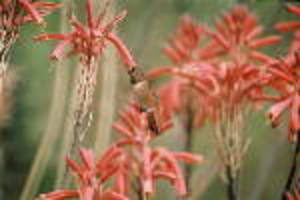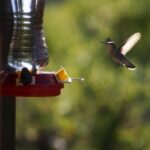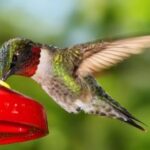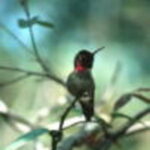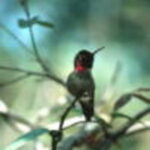Hummingbird fans in Kansas generally have six months out of the year to enjoy the amusing antics of several species of hummingbirds, provided, of course, they have a hummingbird garden, hummingbird feeders or even better, a combination of both. Ten species of hummingbirds have been documented in Kansas to date, with six of them commonly seen annually and four that are still determined to be rare, but have been documented. The six common species are Ruby-throated, Rufous, Broad-billed, Black-chinned, Anna’s and Magnificent. The four rare species are Calliope, Allen’s, Costa’s and Broad-tailed. These ten species should be visiting Kansas beginning in April and usually move on sometime in September.
Most hummingbird fans simply enjoy the sight of these tiny little birds without concerning themselves with whether they are a common Ruby-throated hummingbird or a more unusual Calliope hummingbird. But, there are those people who would like to identify their visitor; my hope is that this article will benefit them as they set out on this quest.
To begin identifying the hummingbirds in Kansas, it will be easiest to describe the most common species first. With this in mind, we will begin identification with the Ruby-throated Hummingbird. The male Ruby-throated Hummingbird is the easiest of the sexes to identify because of its bright red throat that lends itself to the name of the species and its forked tail. The male also has black feathers on the side of its head below its eyes and onto its chin with green feathers covering the flanks and sides. Female Ruby-throated Hummingbirds can be identified by their rounded tails with white tipped outer tail feathers and white chins. Both males and females, however, have metallic bronze-green colored feathers that cover their crowns, napes, backs, rumps and their two middle tail feathers.
The Rufous Hummingbird, another species named for the characteristics of the male, is another commonly seen hummingbird in Kansas. Identification of this species of hummingbird begins with the male, just like the Ruby-throated Hummingbird. The male Rufous Hummingbird is predominately rufous, or rust, colored with their crown, tail and sides rufous and their back can be rufous, green or a combination of rufous and green and their gorget is bright orange-red colored. The female Rufous Hummingbird is green feathers that cover their crown and back, a streaked throat and its tail has rufous colored sides and base with white tips on the outer tail feathers.
The Broad-tailed Hummingbird is one of the rarer hummingbirds that visit Kansas annually. Identifying the male Broad-tailed Hummingbird is accomplished two ways. Of course, it can be identified with the color patterns on its body, just like the other hummingbirds in Kansas, but it is also identified by the sound the male’s wings make when it is in flight, which sounds similar to a cricket. The plumage of the male Broad-tailed Hummingbird includes green feathers on the back and crown, white feathers on the breast, a rose gorget and a rounded tail. The female is less colorful, but has a green back and crown, a throat that is white, a breast that is white with black spots and has rusty colored sides. If this tiny bird perches long enough to study its tail, you will see that its outer tail feathers have a black colored middle and white tips.
The Calliope Hummingbird is another rare hummingbird that has been documented in Kansas. This is a very small hummingbird, with males weighing 2.5 grams and females weighing 2.8 grams. The male Calliope Hummingbird has metallic green feathers covering its back and crown, a gorget that is white with purple ray that give the effect of being “whiskered”. The female Calliope Hummingbird, like the male, has a green crown and back, but it is not as bright as the male’s metallic green crown and back. This female hummingbird also has a white throat with dark streaks, not purple rays, sides that are covered in buff colored feathers and the corners of its tail feathers are tipped with white.
The Black-chinned Hummingbird, which is on the list of commonly seen hummingbirds in Kansas, is not known for its bright colorful males, like most other hummingbirds. This hummingbird, however, does have metallic green feathers covering its back, crown and breast. The most identifiable feature this male hummingbird has is its purple throat band and white collar that are located on a black gorget. The female Black-chinned Hummingbird is even less colorful than its male, with its commonly colored green back and crown, its white breast and black spotted, white throat. This female hummingbird is similar to other female hummingbirds because it has buff colored sides and white tipped tail feathers.
The Anna’s Hummingbird, one more commonly seen hummingbird in Kansas, is one of the larger hummingbirds in the nation, with males weighing 4.3 grams and females weighing 4.07 grams. Metallic green feathers covering its back, dark rose-red feathers covering its crown and gorget and gray feathers covering its breast, identify the male. The female, on the other hand, has a less colorful, green back, a lighter gray breast, a white throat that has red spots and white tipped outer tail feathers.
The Magnificent Hummingbird, another common hummingbird in Kansas, is the nation’s second largest hummingbird and Kansas’ largest hummingbird, with males weighing 7.7 grams and females weighing 6.4 grams. If the size of these birds does not help identify them, then the plumage is the next step. Males have dark green feathers that cover their back, purple feathers that cover their forehead and crown, a metallic green gorget and black feathers that cover their breast. Female Magnificent Hummingbirds have olive green feathers that cover their back and crown, gray feathers that cover their breast and throat and pearl-gray colored outer tail feather tips.
Allen’s Hummingbird is another of the rare species of hummingbird documented in Kansas. The male Allen’s Hummingbird is identifiable by its head and back that are metallic bronze-green, its gorget that is iridescent coppery-red and it flanks that are rufous. Female Allen’s Hummingbirds are identified by their backs and sides that are rufous colored, a breast that is white, a white and red spotted throat and a white tipped rounded tail.
Costa’s Hummingbird, the last of the rare hummingbirds in Kansas, prefers to feed on red penstemon, making this plant definitely one that should be included when planning a hummingbird garden. After including this plant in the hummingbird garden, identifying whether the hummingbird enjoying the nectar is a Costa’s Hummingbird begins with learning to identify this species, starting with the male, who has metallic green feathers covering his back, violet-purple feathers covering his crown and gorget. He also has side throat feathers that are longer than usual and green feathers covering his breast. A female Costa’s Hummingbird has a less brilliant green back than the male, along with a green crown. She also has white feathers covering her breast, a white throat, spotted with black spots, buff colored sides and white-tipped tail feathers.
The Broad-billed Hummingbird, who is on the list of common hummingbirds in Kansas, is known to sit still longer than most other species, but knowing this information is not enough to identify a hummingbird. Looking at the coloration of the plumage of the bird in question is always a good idea when attempting to identify the visiting hummingbird. The male Broad-billed Hummingbird is brightly colored with dark green feathers covering its back, crown and breast, along with metallic blue feathers covering its gorget and a bill that is orange-red with a black tip. The female Broad-billed Hummingbird is not unlike most other female hummingbirds in that she is less colorful than the male of the species. She has green feathers covering her back and crown, gray feathers covering her throat and breast, white-tipped outer tail feathers and finally, an orange-red bill.
